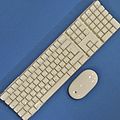






8.6. Personal Networks [src]
A personal area network (PAN) is a computer network used for communication among computer devices, including telephones and personal digital assistants, in proximity to an individual's body. The devices may or may not belong to the person in question. PANs can be used for communication among the personal devices themselves (intrapersonal communication), or for connecting to a higher level network and the Internet (an uplink).
Personal area networks may be wired with computer buses such as USB and FireWire. A wireless personal area network (WPAN) is also possible with wireless network technologies such as IrDA, Bluetooth, Wireless USB, and Body Area Network (along with more home-oriented technologies, like INSTEON, Z-Wave and ZigBee). Typically, a wireless personal area network permits communication within about 10 meters (33 ft).
A WPAN could serve to interconnect all the ordinary computing and communicating devices that many people have on their desk, in their office, or carry with them today — or it could serve a more specialized purpose such as allowing the surgeon and other team members to communicate during an operation.
A key concept in WPAN technology is known as "plugging in". In the ideal scenario, when any two WPAN-equipped devices come into close proximity (within several meters of each other) or within a few kilometers of a central server, they can communicate as if connected by a cable. Another important feature is the ability of each device to lock out other devices selectively, preventing needless interference or unauthorized access to information.

Desktop PC
By Martinultima at en.wikipedia [GFDL], from Wikimedia Commons
Technology
Bluetooth [src]
A Bluetooth PAN is also called a piconet, and is composed of up to 8 active devices in a master-slave relationship (a very large number of devices can be connected in "parked" mode). The first Bluetooth device in the piconet is the master, and all other devices are slaves that communicate with the master. The devices can switch roles, by agreement, and the slave can become the master (for example, a headset initiating a connection to a phone will necessarily begin as master, as initiator of the connection; but may subsequently prefer to be a slave). A piconet typically has a range of 10 meters (33 ft), although ranges of up to 100 meters (330 ft) can be reached under ideal circumstances.
Bluetooth provides a secure way to connect and exchange information between devices such as faxes, mobile phones, telephones, laptops, personal computers, printers, Global Positioning System (GPS) receivers, digital cameras, and video game consoles.

SonyEricsson P910i mobile phone is linking with HBH-600 cordless headset via BlueTooth interface
By User User:SElefant (Own work) [GFDL or CC-BY-SA-3.0], via Wikimedia Commons

Wireless keyboard & mouse
By Hannes Grobe/Hannes Grobe (Own work) [CC-BY-3.0], via Wikimedia Commons
Wireless USB [src]
Wireless USB (WUSB) is a short-range, high-bandwidth wireless radio communication protocol is capable of sending 480 Mbit/s at distances up to 3 meters (10 ft) and 110 Mbit/s at up to 10 meters (33 ft)using Ultra-WideBand (UWB) common radio.
WUSB is used in game controllers, printers, scanners, digital cameras, MP3 players, hard disks and flash drives. Kensington released a Wireless USB universal docking station in August, 2008. It is also suitable for transferring parallel video streams.
The WUSB architecture allows up to 127 devices to connect directly to a host. To facilitate migration from wired to wireless, WUSB introduced a new Device Wire Adapter (DWA) class. Sometimes referred to as a "WUSB hub", a DWA allows existing USB 2.0 devices to be used wirelessly with a WUSB host. WUSB host capability can be added to existing PCs through the use of a Host Wire Adapter (HWA). The HWA is a USB 2.0 device that attaches externally to a desktop or laptop's USB port or internally to a laptop's MiniCard interface.
WUSB also supports dual-role devices (DRDs), which, in addition to being a WUSB device, can function as a host with limited capabilities. For example, a digital camera could act as a device when connected to a computer and as a host when transferring pictures directly to a printer.

Wireless USB keyboard
By Kozuch (Own work) [CC-BY-SA-3.0 or GFDL], via Wikimedia Commons

DWA, wireless & wired
By Rob Blanco (Own work) [CC-BY-SA-2.5-es], via Wikimedia Commons
IrDA [src]
The Infrared Data Association (IrDA) defines physical specifications communications protocol standards for the short-range exchange of data using infrared light. An IrDA PAN is a very short-range (1 meter or about 3 ft) example of free space optical communication.
IrDA interfaces are used in medical instrumentation, test and measurement equipment, palmtop computers, mobile phones, and laptop computers.
For devices to communicate via IrDA, they must have a direct line of sight similar to a TV remote control.
IrDA was popular on PDA's, laptops and some desktops during the late 90s through the early 2000s. However, it has been displaced by other wireless technologies such as WiFi and Bluetooth, favored because they don't need a direct line of sight, and can therefore support hardware such as mice and keyboards. It is still used in some environments where interference makes radio-based wireless technologies unusable.
Body area network [src]
A body area network (BAN), also referred to as a wireless body area network (WBAN) or a body sensor network (BSN), is a wireless network of wearable computing devices. BAN devices may be embedded inside the body, implants, may be surface-mounted on the body in a fixed position, wearable technology or may be devices which humans can carry abput their person.
Initial applications of BANs are expected to appear primarily in the healthcare domain, especially for continuous monitoring and logging vital parameters of patients suffering from chronic diseases such as diabetes, asthma and heart attacks.

Mobile phone infrared data communications – public domain image

Psion Siena 512k palmtop organiser with infrared port
By Snowmanradio (Own work) [GFDL or CC-BY-SA-3.0-2.5-2.0-1.0], via Wikimedia Commons

TV remote control – public domain image







